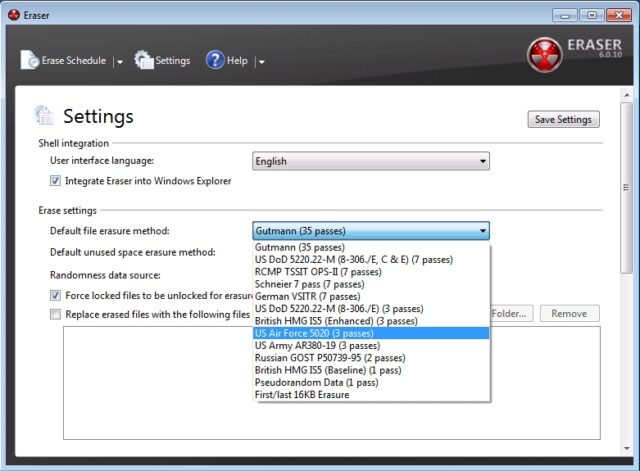Eraser is a hard drive wiper for Windows which allows you to run a secure erase and completely remove sensitive data from your hard drive by overwriting it several times with carefully selected patterns.

Eraser is a Windows focused hard drive wiper and is currently supported under Windows XP (with Service Pack 3), Windows Server 2003 (with Service Pack 2), Windows Vista, Windows Server 2008, Windows 7,8 ,10 and Windows Server 2012.
Secure drive erasure methods are supported out of the box. Erases files, folders and their previously deleted counterparts. Works with an extremely customizable scheduler.
Why a Secure Erase Hard Drive Wiper is important?
A lot of people underestimate the importance of this, especially if you are throwing out an old hard disk or selling something on that contains a hard disk (an old laptop or desktop).
Your first thought may be that when you ‘delete’ the file, the data is gone. But that is not true, when you delete a file, the operating system does not really remove the file from the disk; it only removes the reference of the file from the file system table.
The file remains on the disk until another file is created over it, and even after that, it might be possible to recover data by studying the magnetic fields on the disk platter surface.
Before the file is overwritten, anyone can easily retrieve it with a disk maintenance or an undelete utility.
That is why it’s critical to erase your disks properly before finding them a new home (be that a bin, recycling plant or selling them on).
Depending on the value of the date, select one of the below secure wipe algorithms.
Secure Erase Hard Drive Wiper Methods
Pseudorandom data, 1 Pass, The fastest wiping scheme. Your data is overwritten with random data (if you use a CSPRNG the data is indistinguishable from random noise.)
British HMG IS5 (Baseline), 1 Pass, Your data is overwritten with zeroes.
Russian GOST P50739-95, 2 Passes, GOST P50739-95 wiping scheme calls for a single pass of zeroes followed by a single pass of random data
British HMG IS5 (Enhanced), 3 Passes, British HMG IS5 (Enhanced) is a three pass overwriting algorithm: first pass – with zeroes, second pass – with ones and the last pass with random data.
US Army AR380-19, 3 Passes, AR380-19 is data wiping scheme specified and published by the U.S. Army. AR380-19 is three pass overwriting algorithm: first pass – with random data, second with a random byte and the third pass with the complement of the 2nd pass
US Department of Defense DoD 5220.22-M (E), 3 Passes, DoD 5220.22-M (E) is a three pass overwriting algorithm: first pass – with zeroes, second pass – with ones and the last pass – with random data
US Air Force 5020, 3 Passes, US Air Force 5020 is a three pass overwriting algorithm with the first pass being that of a random byte, followed by two passes of complement data (shifted 8 and 16 bits right respectively)
US Department of Defense DoD 5220.22-M(ECE), 7 Passes, DoD 5220.22-M(ECE) is seven pass overwriting algorithm: first, fourth and fifth pass with a random byte, its 8 right-bit shift complement and 16 right-bit shift complement; second and sixth passes with zeroes, and third and seventh pass with random data
Canadian RCMP TSSIT OPS-II, 7 Passes, RCMP TSSIT OPS-II is a seven pass overwriting algorithm with three alternating patterns of zeroes and ones and the last pass – with a random byte
German VSITR, 7 Passes, The German standard calls for data to be overwritten with three alternating patterns of zeroes and ones and in the last pass with random data
Schneier’s Algorithm, 7 Passes, The Bruce Schneier algorithm has seven passes: first pass – with ones, the second pass – with zeroes and then five times with random data
You can download Eraser here:
Or read more here.

kruug says
Does this handle SSD’s properly? Nothing on the website talks about it aside from referencing “Secure drive erasure methods”.
If this is only for mechanical drives, what do you recommend for SSD drives?
Darknet says
Nope, SSDs are a different case – the manufacturer should have a tool to ‘zero’ the drive and basically reset the drive using a higher voltage surge. Google your SSD brand + toolbox you should be able to find it.
MEHMET says
which we use algorithm?
Darknet says
Depends how important it is? Most of the 3 pass would be fine, my preference is British HMG IS5 (Enhanced).
Bogwitch says
The better option is to encrypt your drive from the outset.
As long as you’re using a strong key to encrypt your drive and a strong password to protect the key, the data is unrecoverable.
Be aware of the recently discovered problems with hardware encryption!